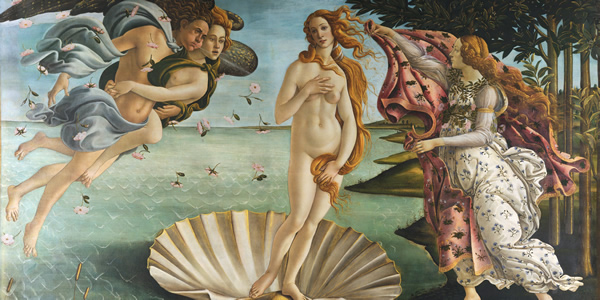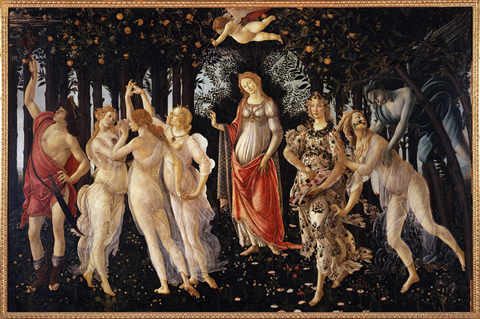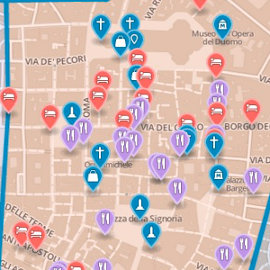The Uffizi Galleries serve as a kind of real-life textbook on the development of the Renaissance from the 13th to the 18th centuries.
That's a fancy way of saying that this (relatively) tiny museum has some of the greatest paintings by some of the greatest artists of the early and High Renaissance—the short list includes Giotto, Botticelli, Leonardo da Vinci, Michelangelo, Raphael, Titian, and Caravaggio.
And those are just a few of the artists in just seven of the Uffizi's 100 rooms.
It can be downright exhausting.
Although the Uffizi is only a fraction of the size of galleries like the Louvre or Vatican, it still ranks in the world's top echelon of museums. What it lacks in quantity, it more than makes up for in quality, with room after room of unequivocal masterpieces. What looks like a small stretch of gallery space can easily gobble up half a day.
In fact, many rooms suffer the fate of containing nothing but masterpieces.
The Uffizi building—itself a 16C masterpiece of Renaissance architecture by Giorgio Vasari—is an elongated U shape, with rooms opening off the U's two long corridors. These corridors are lined by ancient sculptures under ceilings elaborately painted to celebrate the history of Florence and the ruling Medici clan, whose private offices ("uffizi" in old Florentine dialect) these were and whose private art collection this once was.
The final heir of the Medici line, Maria Luisa de' Medici, stipulated in her will two things regarding this fabulous collection of timeless artistic masterpieces. (1) No part of it was ever allowed to be sold off and leave Florence. (2) It all be opened to the public.
God bless you, Maria Luisa.
Note: Though you enter on the ground floor (piano terra), the exhibition starts on the topmost, third floor—which in Italian is (somewhat confusingly) called the secondo piano. Since the expansion, the exhibition then continues down to the second floor (in Italian: primo piano).
UFFIZI: SECONDO PIANO
The first corridor
[Note: Until spring 2015; Rooms 2–7 will be getting their first overhaul and restoration since the 1950s; the best of the works from these rooms—covering medieval and early Renaissance painting—will be temporarily displayed in Rooms 43–45, near the end of the second floor's Second Corridor.]
Uffizi Room 2: A tale of three Madonnas (and why Giotto is so awesome)

Cimabue's Santa Trinita Maestà (c.1285).
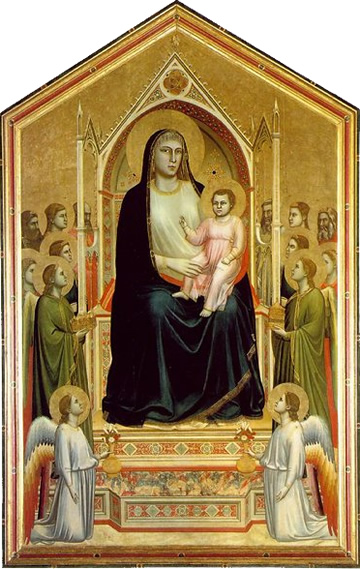
Giotto's Ognissanti Maestà (c.1310). You get off to a roaring start with the trio of giant Maestà paintings in the first room. Together, these "Madonna in Majesty"—the Virgin Mary seated on a throne as the Queen of Heaven, often bobbling a baby Jesus on her lap—offer a crash course in the roots of the Renaissance, showing in a very visual way how the Renaissance began and what made it different from everything that came before.
Painting quickly moved from the rigid, Byzantine style of Cimabue's version through some more earthy (and decorative) Gothic elements courtesy of the Sienese great Duccio, to the point where painting is completely transformed by the artist who broke all the rules and in the process catalyzed Renaissance painting, Giotto.
On the right is Cimabue's Santa Trínita Maestà (1280), still very much rooted in the Byzantine traditions that governed painting in the early Middle Ages—an Eastern-style inlaid throne, spoon-like depressions above the noses, highly posed figures, a typically Byzantine drapery of blue and red robes finely incised with a hatchwork of gold leaf, and cloned angels with identical faces stacked up along the sides.
On the left is Duccio's Rucellai Maestà (1285), painted by the master who studied with Cimabue and eventually founded the Sienese school of painting. The style is still thoroughly medieval but introduces innovations into the rigid traditions. There's a little more weight to the Child Madonna holds, and the Madonna's face has a more human, somewhat sad, expression.
In the center of the room is Giotto's incredible Ognissanti Maestà ★★★ (1310), by the man who's generally credited as the founding father of Renaissance painting.
It is sometimes hard to appreciate just how much Giotto changed when he junked half the traditions of painting to go his own way. It's mainly in the very simple details, the sorts of things we take for granted in art today, such as the force of gravity, the display of basic emotions, the individual facial expressions, and the figures who look like they have an actual bulky body under their clothes.
Giotto's Mary face is a naturalistic study of a sturdy peasant woman, not the almond-eyed, arrow-nosed Byzantine ideal of unearthly beauty in Cimabue. She sways slightly to one side, the fabric of her off-white shirt pulling realistically against her breasts as she twists.
The attendant angels in the Giotto are all individuals (their faces unique) and are milling about, halos bumping into one another, while standing firmly on the ground, not identical angelic clones floating around merely to decorate the margins.
(Also, Giotto—though still a generation from the development of true perspective—uses ingenious little tricks to show depth, like having two of the deep background angels peer at the scene through the windows in the side of the throne.)
The differences between these works is staggering—not because one is "better" than the other (it isn't), but because of what each has to say about how a painting should be done.
All three artists were great masters. It's just that Giotto was the master who was pointing to the future, while Cimabue had only mastered what had come before and Duccio only built upon that. That this quantum leap in art happened within a single generation makes it all the more remarkable. The works were painted a mere 25 years apart.
The icing on the cake? Cimabue had actually been Giotto's teacher. Cimabue discovered the former shepherd as a lad, using a sharp rock to idly scratch sketches of his sheep into a boulder and took him under his wing.
And all that's just in the first room—and I didn't even get to any of the other works in this room.
Like I said: small museum; major collection. (OK, I promise: no more lengthy art history lessons.)
Uffizi Room 3: The Gothic Sienese School

Simone Martini's Annunciation (1333)
Room 3 pays homage to the 14th-century Sienese school with several delicately crafted works by Simone Martini and the Lorenzetti brothers.
Here is Martini's Annunciation ★ (1333), one of my favorite paintings in the gallery since I was 12 years old. Note that Mary—who, in so much art both before and after this period is depicted as meekly accepting her divine duty when the archangel Gabriel arrive to announce her imminent Immaculate Conception—looks reluctant, even disgusted, at the news in Martini's interpretation, draws back violently and looking distinctly disbelieving.
Brothers Pietro and Ambrogio Lorenzetti helped revolutionize Sienese art and the Sienese school before succumbing to the Black Death in 1348. Of their work here, Ambrogio's 1342 Presentation at the Temple is the finest, with a rich use of color and a vast architectural space created to open up the temple in the background.
Uffizi Rooms 4–6: International Gothic
Room 4 houses the works of the 14th-century Florentine school, where you can clearly see the influence Giotto had on his contemporaries like Bernardo Daddi and Orcagna. (Much of the best work by this era of Trecento Florentine painters is actually in fresco form, scattered around the churches in town).
Rooms 5 and 6 represent the dying gasps of International Gothic—Fra' Angelico, Jacopo Bellini, Lorenzo Monaco, and Gentile da Fabriano—still grounded in medievalism but admitting a bit of the emergent naturalism and humanist philosophy into their works.
Lorenzo Monaco's Coronation of the Virgin (1413) is particularly beautiful, antiquated in its styling but with a delicate suffused coloring.
Gentile da Fabriano’s Adoration of the Magi (1423) was commissioned by the Strozzi, a powerful Florentine clan of merchants and textile magnates, which is why the figures in the painting are showing off all the latest textiles and patterns—sort of art as company catalogue.
Uffizi Room 7: Cue the Renaissance
In Room 7, the Renaissance proper starts taking shape, driven primarily by the quest of two artists, Paolo Uccello and Masaccio, for perfect perspective.
On the left wall is Paolo Uccello's Battle of San Romano (1456), famously innovative but also rather ugly. This painting depicts one of Florence's great victories over rival Siena, but for Uccello it was more of an excuse to explore the newly developed technique of "perspective"—with which this painter was, by all accounts, positively obsessed. In one corner of his large canvas a soldier has even, in the words of one great art historian, "managed to die in perspective." (If this painting looks vaguely familiar, it may be because it was originally one of three depicting the entire battle that were painted to hang on the walls of a Medici cousin's bedchamber; the other two canvases from this ersatz triptych are now in Paris at the Louvre and in London at the National Gallery.)
In the far corner is the only example of Masaccio's art here (he died at age 27), the Madonna and Child with St. Anne,which he helped his master, Masolino, paint in 1424. Masaccio's earthy realism and sharp light are evident in the figures of Mary and the Child, as well as in the topmost angel peeking down.
In the center of the room is Piero della Francesca's Portrait of Frederico da Montefeltro and Battista Sforza ★★★, painted around 1465 or 1470 and the only work by this remarkable Sansepolcran artist to survive in Florence. The fronts of the panels depict the famous duke of Urbino and his wife, while on the backs are horse-drawn carts symbolic of the pair's respective virtues.
Piero's incredibly lucid style and modeling and the detailed Flemish-style backgrounds need no commentary, but do note he purposefully painted the husband and wife in full profile—without diluting the realism of a hooked nose and moles on the duke—and mounted them face to face, so they'll always gaze into each other's eyes.
Rooms 8–9: Getting ready for Botticelli
Room 8 is devoted to Fra' Filippo Lippi—debauched monk, bon vivant, and teacher of a young Botticelli—with more than half a dozen works by the lecherous monk who turned out rich religious paintings with an earthy quality and a three-dimensionality that make them immediately accessible.
His most famous painting here is the Madonna and Child with Two Angels (1455–66). Also here are a few works by Filippo's illegitimate son, Filippino Lippi (who, in a nice passing of the torch, was in turn a student of Botticelli).
Room 9 is an interlude of virtuoso paintings by Antonio del Pollaiolo, plus a number of large Virtues by his less-talented brother, Piero. These two masters of anatomical verisimilitude greatly influenced the young Botticelli, three of whose early works reside in the room.
This introduction to Botticelli sets us up for the next room, invariably crowded with tour-bus groups.
Uffizi "Rooms" 10–14: The Botticelli Room
[Note: In spring 2015; The Botticelli Room will be getting its first restoration in decades; the best of the Botticellis—including, of course, the Birth of Venus and Primavera—will be temporarily displayed in Room 41, about halfway down the second floor's Second Corridor. These iconic works should remain there until early 2016, when they will be moved back and Room 41 is given over to Flemish and other northern Renaissance works.]
The walls separating Rooms 10 to 14 were knocked down in the 20th century to create one large space to accommodate the resurgent popularity of Sandro Filipepi—better known by his nickname, Botticelli ("little barrels")—master of willowy women in flowing gowns.
Fourteen Botticelli paintings line the walls, along with works by his pupil (and illegitimate son of his former teacher) Filippino Lippi and by his contemporary Domenico Ghirlandaio, Michelangelo's first artistic master.
But everybody flocks here for just two paintings:
In Botticelli's Birth of Venus ★★, the love goddess is born of the sea on a half shell, blown to shore by the Zephyrs. Ores, a goddess of the seasons, rushes to clothe her.
Some say the long-legged goddess was modeled on Simonetta Vespucci, a renowned Florentine beauty and the not-so-secret lover of Giuliano de' Medici, Lorenzo the Magnificent's younger brother. (Fun fact: Simonetta was married to a cousin of the future Amerigo Vespucci, the naval explorer after whom America is named).
Botticelli's Primavera (Allegory of Spring) ★★ is harder to evaluate, since contemporary research indicates it may not actually be an allegory of spring influenced by the humanist poetry of Poliziano but rather a celebration of Venus, who stands in the center, surrounded by various complicated references to Virtues through mythological characters.
Though in later life Botticelli was influenced by the puritanical preachings of Savonarola and took to cranking out vapid Madonnas (a few on display in this room), the young painter began in grand pagan style. Both of these large, famous paintings were commissioned between 1477 and 1483 by a Medici cousin for his private villa, and they celebrate not only Renaissance art's love of naturalism but also the humanist philosophy permeating 15th-century Florence, a neo-Platonism that united religious doctrine with ancient ideology and mythological stories.
The tour-bus crowds tend to plant themselves in front of these for 20 minutes at a time, so you may have to wait for a good look. Pass the time you wait studying the other paintings in this room, like Botticelli's Adoration of the Magi, where the artist painted himself in the far right side, in a great yellow robe and golden curls.
Uffizi Room 15: The High Renaissance & Leonardo da Vinci
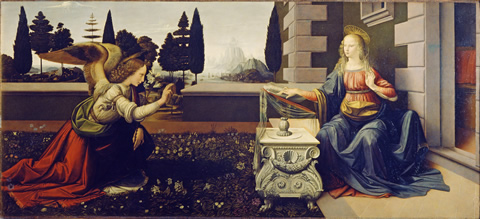
Leonardo da Vinci's Annunciation (1475-80).
Room 15 boasts Leonardo da Vinci's Annunciation (1475-80) ★★★, which the young artist painted in 1472 or 1475 while still in his 20s and studying in the the workshop of his master, Andrea del Verrocchio; however, he was already fully developed as an artist. The solid yet light figures and sfumato airiness blurring the distance render remarkably life-like figures somehow suspended in a surreal dreamscape.
Leonardo helped his master on Andrea del Verrocchio's Baptism of Christ (1475–78)—most credit the young da Vinci with painting the curly-haired angel on the lower left (another, older apprentice—Botticelli—may have painted the angel next to Da Vinci's) as well as the landscape, and a few art historians think they see Leonardo's hand in the figure of Jesus as well. According to Vasari, when Verrocchio saw Da Vinci's angel, he was so humbled by his student's mastery that he put down his brushes and vowed never to paint again. (Good thing he had a successful career as a sculptor to fall back on.)
Leonardo da Vinci'sAdoration of the Magi (1481), which Leonardo didn't get much beyond the sketching stage before his decamped for Milan (and, eventually, Paris)—evidence that Da Vinci was already well into his habit of rarely finishing what he started. However, even grossly unfinished, it shows how he could retain powerful compositions even when creating a fantasy landscape of ruinous architecture and incongruous horse battles. [Note: This painting was taken to the Opificio delle Pietre Dure—Florence's main restoration studio—in late 2012 for study and a subsequent restoration that is estimated to last several years.]
Pietro Perugino's Pietà showcases the Umbrian master's solid plastic style of studied simplicity, which he would later pass on to his most famous pupil, Raphael.
The room also houses works by fellow late-15th-century maestros Lorenzo di Credi and Piero di Cosimo.
Room 16, opening off the left side of Room 15, is currently closed. It previously held a collection of maps and minor works that were thoroughly ignored by most visitors (and were, in fact, often closed). However, in keeping with the didactic arrangement of the rest of the New Uffizi, I can only assume that this is where will soon reside a few major 15C paintings that used to hang in Room 19 but are no longer there following the rearrangement, particularly Perugino's luminous Portrait of Francesco delle Opere (1494) and Luca Signorelli's Sacra Famiglia di Parte Guelfa (Holy Family) (1490–95) was painted as a tondo set in a rectangle with allegorical figures in the background and a torsion of the figures that were to influence Michelangelo's version (in a later room).
No matter what, Room 16 is a dead end. You return to Room 15, where an exit spills you back into the main corridor for a stretch. The next room you enter is actually numbered Room 18.
Room 18: The Tribune
Uffizi officials use the small octagonal room called the Tribuna—designed by Buontalenti in 1584 with a pietra dura (stone inlay) floor, mother-of-pearl ceiling dome, and bloodred walls covered with High Renaissance and Mannerist paintings—as a crowd-control pressure valve. You may find yourself stuck shuffling around it quite slowly, studying the antique statues and scrutinizing the Medici portraits wallpapering the room.
The latter include many by the talented early baroque artist Agnolo Bronzino, whose portrait of Eleonora of Toledo, wife of Cosimo I, with their son Giovanni de' Medici (1545) ★, is particularly well worked. It shows her in a satin dress embroidered and sewn with velvet and pearls. When the Medici tombs were opened in 1857, her body was found buried in this same dress (it's now in the Pitti Palace's costume museum).
Also here are Raphael's late St. John the Baptist in the Desert (1518) and mannerist Rosso Fiorentino's Angel Musician (1522), where an insufferably cute little putto (cherub) plucks at an oversized lute—it's become quite the Renaissance icon in the recent spate of angel mania.
In the center of the Tribuna is ranged a handful of choice ancient statues, including a pair of wrestlers displaying a rather, er, interesting hold that is extremely illegal today (let us just say this hold is only practicable if you happen to be male and wrestle nude, as the ancient Greeks did), and the famous Medici Venus, a 1st century BC copy of Praxiteles' original Aphrodite of Cnidos (Praxiteles was the Michelangelo of Ancient Greece, though most of what we know of his work is through copies like this one).
Rooms 19–23: The Quattrocento beyond Florence
This is where the Uffizi most of us knew (and got mentally exhausted by) for more than 60 years really starts to change, thanks to the Grande Uffizi project.
Home for decades to mostly Northern Italian and Northern European works (which everybody would just blow through, intent on sticking to the Italian Renaissance), this string of small, narrow rooms with lovely frescoed ceilings have now become a repository for the Uffizi's greatest paintings by early Renaissance artists working outside of Florence in the 15th century—an era called, in Italian, Il Quattrocento.
Room 19 starts close to home, with the Quattrocento Senese of Siena, including to large altarpieces of the Madonna and Child Enthroned with Saints —one by Il Vecchietta and the other by Giovanni di Paolo—as well as works by Matteo di Giovanni and Sano di Pietro.
Room 20 has the greatest artists and works representing the Quattrocento from other regions Italy. Top honors go to Andrea Mantegna's Portrait of Cardinal Carlo de Medici and his Stories from the Life of Christ: Adoration of the Magi, Circumcision, and Ascension (1463–70), a triptych showcasing his excellent draftsmanship and fascination with classical architecture.
Also here: Giovanni Bellini's Portrait of a Gentleman in his red cap and his Alegoria Sacra; and a pair of rare works by pretty much the only early Renaissance master from Sicily, Antonella da Messina.
Room 20 held pretty much all the heavy hitters from the Uffizi collection of Northern Italian Quattrocento masters, so I won't tattle on you if you decide to breeze through the next three rooms: The Quattrocento of the Veneto in Room 21 (Vittore Carpaccio, Cima da Conegliano); the Quattrocento of Emilia-Romagna in Room 22 (Lorenzo Costa, Cosmè Tura); and the Quattrocento of Lombardy in Room 23 (Vincenzo Foppa, Bernardino Luini).
The connecting hall & Vasari's Corridor
Zipping through the Northern Italian Quattrocento is all fine and well, because as soon as you move on around to the second corridor you're going to be right back into the biggest heavy hitters of Old Masters.
First, however, most visitors pause to take a breather in the connecting hall between the two main corridors.
The Uffizi, built in 1560 by Giorgio Vasari for Duke Cosimo I de' Medici, were built as a long, U-shaped building—two long corridors connected by a shorter hall at the Arno River end. The painting galleries are up on the top floor, and the connecting hall (at the base of the "U") offers some fine intimate views of downtown Florence.
Pause to look out the tall windows in one direction down the Uffizi's elongated courtyard that opens into Piazza della Signoria at the far end, and then out the opposite windows for a panorama over the Arno River, Ponte Vecchio, and the Corridorio Vasariano (below).
That odd covered corridor extending from the Uffizi, zigzagging over to cross the Ponte Vecchio atop its famous little shops, then disappearing into the Oltrarno on the other side is the Corridorio Vasariano.
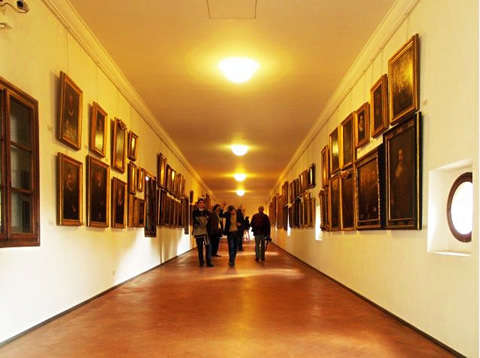
The Vasari CorridorIt was built by Vasari for Cosimo I de' Medici so the Duke could walk the kilometer (0.6 miles) from his home at the Pitti Palace here to his downtown "uffizi" (which means "offices" in old Florentine) without having to mix with the hoi polloi on the streets.
Incidentally, those little shops once held butchers, who could conveniently toss their offal into the river below. Once the Duke started walking across the tops of the shops every morning, he found the stench unbearable. He evicted the butchers and replaced them with something more becoming for a duke to walk over: gold– and silversmiths. The bridge remains lined by jewelry shops to this day.
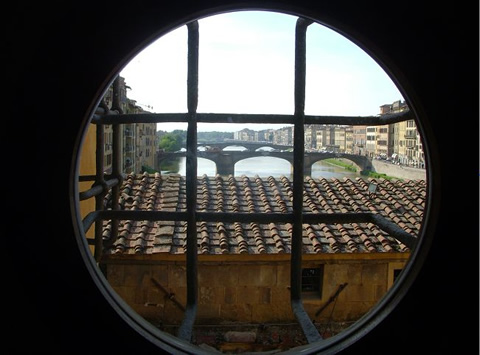
View from the Vasari CorridorYou can actually tour the corridor—lined by a remarkable collection of self-portraits by a variety of Renaissance and baroque artists and tiny windows offering ducal peekaboo views over Florence—though its only open to the public sporadically.
Last time around it was open Tues. and Thurs. 9am–11:30am, Wed. and Fri. 2–4:30pm. Call tel. +39-055-265-4321 to find out if and when it is currently open and to reserve an entry time (obligatory)—or book a tour:
The second corridor
Uffizi Rooms 34–33: Ancient sculpture
The first room you come to in the second corridor is a shock: No paintings, just ancient sculptures.
It's worth popping into Room 34, though, because these were some of the statues and reliefs that decorated the Medici sculpture garden by San Marco, where Lorenzo de' Medici set up Donatello's star pupil, Bertoldo di Giovanni, as head of a carving school. One of Bertoldo's first students: A teenaged Michelangelo, escaping from the fresco studio of Ghirlandaio and picking up a hammer and chisel to learn his primary artistic love.
It is said that young Michelangelo labored over a statue of a satyr, inspired by an ancient original in the garden. One day, Lorenzo The Magnificent wandered into the garden and lightly teased the young sculptor, saying of the statue's leering face that an old man like that wouldn't have a full set of teeth. As soon as Lorenzo was gone, Michelangelo set about knocking out one of the teeth and carving a pit into the "gums;" he then rubbed dirt into the marble to give it a patina of age and anxiously awaited Lorenzo's return.
The impressed prince of Florence soon invited Michelangelo to live in the Medici palazzo.
(Zagazig Room 33, just beyond, has Roman copies of Greek sculptures, mostly portrait busts.)
[I know it looks like my room numbering is off there; some rooms are perennially closed, yet they keep the old, original numbers identifying each, so you do actually hit Room 34, then 33.]
Uffizi Room 35: Michelangelo and the Florentine High Renaissance
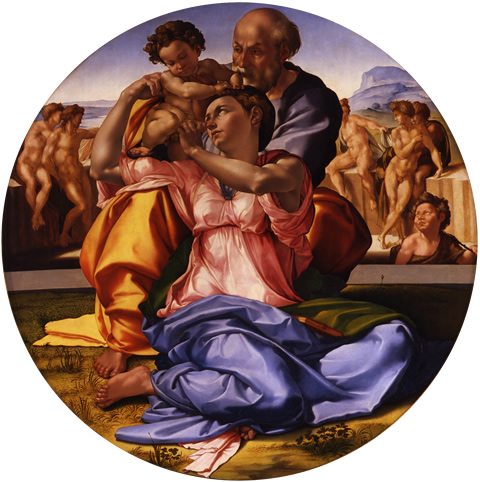
Michelangelo's Holy Family or Doni Tondo (1504–05).
Michelangelo's bright and colorful Holy Family ((1506–08) ★★★ signals our dive into the High Renaissance. Also known as the Doni Tondo ("tondo" because it is round; "Doni" after Agnolo Doni, who commissioned the piece for a family wedding)—this one of the few panel paintings by the great master. The glowing colors and shocking nudes in the background seem to pop off the surface, and the torsion of the figures was to be taken up as the hallmark of the 16th century mannerist movement (more on that when we get downstairs). Michelangelo also designed the elaborate frame.
Keeping the Doni Tondo company in this room are works by Fra' Bartolomeo—a follower of Savonarola who later took up Dominican robes himself—Francesco Granacci, Alonso Berraguete, and mannerist Andrea del Sarto.
Uffizi Room 41: Botticelli for now; eventually, Flemish and Northern European
This large room will house in 2015 (and likely into part of 2016) the Birth of Venus and Primavera (Allegory of Spring) and other famous works from the Botticelli rooms while those are being refurbished [see Rooms 10–14 for details on the works].
However, the paintings on the one blue wall—Rogier van der Weyden's, Lamentation of Christ, Hans Memling's Madonna and Child with Angels, and Hugo van der Goes's Portinari Triptych—are a hint at what this room will eventually be dedicated to: Northern European works of the 15th and 16th centuries.
(We can only assume they will eventually be joined by the Uffizi's collection of fine 15C and 16C Flemish and German paintings—currently MIA in the new Uffizi layout—by such masters as Hans Holbein the Younger, Dürer, Cranach, and other Northerners who once worked in Florence.)
Room 38: The Hermaphrodite & the early exit
There is a vestibule off the corridor leading to the stairs down tot the exit used in the 1990s and 2000s as well as, just beyond, a small red room reopened in 2015 with a lovely Roman imperial-era copy of a 2C BC Hellenistic of a reclining Hermaphrodite statue acquired by the Medici in 1669 (Though the subject matter seems a bit odd—certainly obscure—this was a very popular type of statue you'll find in many major private collections of the era.)
Also in this room are Jacopo Ligozzi's Allegory of Virtue and other examples of the type of late 17C art preferred by Grand Duke Francesco I de' Medici.
Uffizi Room 42: The Niobids & a Medici Queen of France
Father down the Second Corridor opens Room 42 is a lovely side hall flooded with sunlight and graced by more than a dozen Roman statues which are copies of Hellenic originals, most of them of the dying Niobids.
Against the wall is a monumental canvas by Peter Paul Rubens, The Triumphal Entry of Henry IV into Paris (1627–40) commissioned by Maria de’ Medici for the Palais du Luxembourg. See, though she was born a Medici in Palazzo Pitti, young Maria—sixth child of Grand Duke Francesco I—married way up, becoming the second wife of King Henry IV of France.
As poor Henry was assassinated the day following her coronation as Queen of France, Maria ("Marie" to her subjects) became the regent to their young son, Louis XIII, and later did political battle with her son's other powerful counsellor, Cardinal Richelieu (yes, the baddie in Three Musketeers). Richelieu eventually came out on top, resulting in Queen Marie's banishment —and the abandonment of this glorious cycle of Rubens paintings celebrating her long-dead husband's reign.
Uffizi Rooms 43–45: Temporary exhibition space
These rooms currently act as a holding cell for works from rooms being refurbished (for the first half of 2015 this means the greatest hits from the Uffizi's first set of rooms dedicated to 13th–15th century Gothic and early Renaissance paintings by the likes of Giotto, Duccio, Simone Martini, Fra' Angelico, Paolo Uccello, Masaccio, and Piero della Francesca).
The Cafe—and the view
At the end of the second corridor you can enter a small cafe with access to an outdoor roof terrace atop the Loggia de' Lanzi, featuring close-up views of the Palazzo Vecchio.
Sadly, you cannot get all that close to the edge, and the wall is quite high, so you don't get really the good views down into Piazza della Signoria below that you would expect. No matter; the fresh air makes for a needed break from the swirl of amazing art you've just seen—and there's still more to come, now that the Grande Uffizi project has opened up the ground floor as exhibition space.
UFFIZI: THE SECOND FLOOR
A new staircase leads you down into the Grande Uffizi's expansion of palazzo rooms hung with still more art on the primo piano (second floor).
The Blue Rooms: "Foreign" works of the 16th and 17th centuries (Uffizi Rooms 46–55)
The High Renaissance shades into the baroque as the artistic ideals born in 15th century Florence sweep across Europe, bringing the Renaissance with them.
The rooms are divided mostly along national lines (Spanish, Dutch, Flemish, French) and general eras (late 16C, early 17C, etc.). No real show=stoppers here, but be on the lookout for fine works by Rembrandt ★ (who provided two Self-Portraits, one as a young man one as an elderly one), Diego Velásquez, Francisco Goya, Giuseppe Ribera, El Greco (a Greek who studied in Venice, but since he settled in Toledo he counts as "Spanish"), Jan Steen, Van Dyck, Van Brueughel (mostly the Younger, but also an Elder), Paul Bril, Charles Le Brun, and Simon Vouet.
All of these are fine works, and many would likely be among the centerpieces of other collections. However, this is not other collections, This is the Uffizi, the most embarrassingly masterpiece-laden museum of its size in the world. Most people—especially on a first visit—tend to blow through these northern Renaissance rooms pretty quickly
The Red Rooms I: The Mannerists (Uffizi Rooms 56–61)
Proof that all art is 'modern art'...at least in its own time. The High Renaissance offshoot movement we now call "Mannerism" is an abbreviation of how the works by these artists were referred to at the time, as painting done "nella maniera moderna," which means "in the modern manner." Hence, "Mannerism."
It could have just as easily been called "modernism," but then what would we have called the new styles of art birthed in the late 19th/early 20th century?
Actually, the irony of terming everything from the Impressionists to Abstract Expressionism "modernism" has led us to use the ridiculous and meaningless phrase "post-modern" to describe art from about 1960 on. Does that mean art now lives in an eternal future state, beyond the modern present?
But I digress. Also, I broke my promise about no more art history. Sorry.)
Room 56 is a short hall filled with Hellenistic antiquities to give you a breather before plunging into a section of the oft-overlooked artists of the Mannerist era—though you have to figure they won't be overlooked for much longer, given these special rooms dedicated to them (not to mention the fact that the Mannerist era is the special field of study of Antonio Natali, the the Uffizi's director since 2006).
The startling colors and attention to the musculature of twisting bodies that Michelangelo used in ground-breaking works like the Doni Tondo upstairs influenced a whole generation of artists called "Mannerists"—Andrea del Sarto, Rosso Fiorentino, Pontormo, and Parmigianino—whose works fill next few rooms.
You could consider Mannerism an offshoot of the High Renaissance, a particular Michelangelesque style that flourished among a small group of artists for a few generations before petering out. It was concurrent with the more classical (and Classicist) version of the High Renaissance that spread throughout Europe and would eventually develop (degrade?) into the baroque style that would dominate the 17th and early 18th centuries.
Rooms 57–58: Andrea del Sarto (born Andrea di Agnolo) was the most important painter in Florence in the early 16th century, while Michelangelo and Raphael were off working in Rome. His consciously developed mannerist style is evident in his masterful Madonna of the Harpies (1515–17) in Room 58.
Room 59 is delightfully called "Amici di Andrea," filled with works by del Sarto's friends and contemporaries, including Bachiacca and Francabigio. (There is also Pontoromo's Leda; more on him in two rooms.)
Room 60 is devoted to works by one of del Sarto's greatest mannerist students, Giovanni Battista Rossi, called Rosso Fiorentino. Fiorentino's Moses Defends the Daughters of Jethro (1523) ★ owes much to Michelangelesque nudes but is also wholly original in the use of harsh lighting that reduces the figures to basics shapes of color. It is a shockingly modern work, in some presaging Cézanne and other Impressionists of the late 19th century.
Also check out his Pala dello Spedalingo di Santa Maria Nuova, a "Madonna Enthroned" surrounded by saints John the Baptist, Anthony Abbot, "Stephen," and Jerome. This was commissioned for the church of Ognissanti, but when they saw it they rejected the piece for the ugly leers on the saints—especially the "diabolical face" of the gaunt St. Jerome on the far right—though they can't have been too happy with the heavy Goth eye makeup on the Baby Jesus and Virgin Mary, either. Instead, the altarpiece ended up in a provincial church in the Mugello countryside—but, since the church was dedicated to Santo Stefano, Rosso (or perhaps Ridolfo Ghirlandaio) first added a stone to the head of St. Benedict, second from the right, to turn him into St. Stephen.
Room 61 is dominated by another of del Sarto's star pupils, Jacopo Carrucci, known as Pontormo, including a striking retro-portrait of Cosimo il Vecchio (1519–20), the progenitor of the Medici clan's power (but whom, by the time this was painted, had been dead some 55 years).
Fell free to skip the the treacle and tripe in the two side rooms off the the right, Rooms 62–63, stuffed with substandard examples of 16th century paintings by the likes of Giorgio Vasari, Alessandro Allori, Jacopo Zucchi, L'Empoli, Santi di Tito, and other chaps who grew up in Michelangelo's shadow and desperately wished they could paint like him (note: they couldn't).
The good stuff continues straight ahead in Rooms 64–65, devoted to Pontormo's adopted son, Bronzino who hewed much more closely to the Classical model of the High Renaissance than the intriguingly fraught mannerism of his immediate forbearers. Room 65 is particularly interesting as a collection of Bronzino portraits of various members of the Medici family.
The Red Rooms II: Raphael (Uffizi Room 66)
Now that we've ended the mannerist experiment with Bronzino setting Florentine painting back on the classicism route, we're ready for another show-stopper room dedicated to High Renaissance darling Raffaello di Sanzio.
Of Raphael we have the Madonna of the Goldfinch(1505), a work he painted in a Leonardesque style for a friend's wedding, and several important portraits, including (Medici) Pope Leo X with Cardinals Giulio de' Medici and Luigi de' Rossi and Pope Julius II, as well as a famous and oft-reproduced Self-portrait.
The Red Rooms III: The Late Renaissance (Uffizi Rooms 68–88)
The balance of the "Red Rooms" along this wing of the Uffizi are a grab bag of late Renaissance works, and the room numbering gets a bit hinky, since opening off of them to the right are a series of rooms currently used for temporary exhibitions and therefore only sometimes open.
So, although the room numbers skip around, the permanent collection of the "Red Rooms" continues in a straight line. Here are the highlights.
Room 68 has 16C Roman painting heavily influenced by Michelangelo and Raphael (whose St John the Baptist hangs here), by such artists as Giulio Romano, Daniele da Volterra, and Francesco Salviati, who helped the ideals and look of the Florentine Renaissance flourish in Rome.
Room 71 is home to a passel of Correggio Madonnas.
Room 74 is dominated by late mannerist master Il Parmigianino, who carried the mannerist movement to its logical extremes with the almost grotesquely elongated bodies of the Madonna of the Long Neck (1534) ★.
Room 75 houses Old Testament scenes by the quirkily poetic painter Giorgione, a student of Giovanni Bellini who helped found the Venetian school of the High Renaissance (along with a young colleague/pupil named Titian) but who died of the plague at the age of 30. The room also has canvases by Sienese High Renaissance painter Sebastiano del Piombo; his Death of Adonis and Portrait of a Woman are both strong works.
Room 83 is a long gallery honoring the great Venetian Titian, nearly a dozen canvases including the warm, full-bodied Flora ★★ and a poetic Venus of Urbino ★ languishing on her bed.
Room 88 finishes off the hall with modest works by Lombard painters of the 16C like Lorenzo Lotto and Giovan Battista Moroni.
The Verone connecting hall
This hall connecting back to the northern wing of the Uffizi offers another brief break from the wall-to-wall paintings with a view in one direction of the Arno and in the other of the Uffizi's interior court.
You probably just want to stare out the window for a while and forget about all the art, but in case you are curious:
The bronze statues at either end are the Marte gradivo by Bartolomeo Ammannati, in which the war god is exhorting his troops, and a Silenus with the Baby Bacchus by Jacopo del Duca, which he copied from a Roman statue (that at the time belonged to the Medici but is now in the Louvre) which was, itself, supposedly a copy of an ancient bronze original by Lyssipos, one of the greatest sculptors of ancient Greece.
The large Vaso Medici marble vase in the center of the hall was a prize piece of the collection, a neo-Attic piece from the late 2C BC in astoundingly good shape. It is carved with a relief of Achilles consulting the Delphic Oracle before heading off to the Trojan War. (That was a pretty pointless move, considering the oracle was Apollo's oracle and Apollo really had it in for Achilles, eventually going so far as giving Trojan prince Paris the poisoned arrow that would kill the Greek hero and telling Paris to aim at Achilles' heel.)
OK, rested from all the great art? Good, 'cause there's more.
The Gold Rooms: Caravaggio and the Caravaggieschi (Uffizi Rooms 90–100)
The inimitable Caravaggio—born Michelangelo Meresi, but since there was already a rather famous artist named Michelangelo, he was known as Caravaggio after his birthplace—was the greatest baroque painter in Italy.
Caravaggio was famed for his use of chiaroscuro—painting with a combination of extreme harsh light and deep shadows, giving his work particular drama and power. What this man could do with just one elderly saint's wrinkled forehead...The style he popularized was even named after him: Caravaggiesque.
Room 90 of the Uffizi preserves his painting of the severed head of Medusa, a Sacrifice of Isaac, and his famous Bacchus ★★.
Caravaggio's work influenced a generation of artists—the Caravaggieschi—including Artemisia Gentileschi, the only female painter to make a name for herself in the late Renaissance/early baroque. Artemisia was eclipsed in fame by her slightly less talented father, Orazio, and she was the victim and central figure in a sensational rape trial brought against Orazio's onetime collaborator. It evidently had an effect on her professional life; among her paintings here in Room 90 is the violent Judith Slaying Holofernes.
Rooms 91–93 contain more Caravaggiesque works by Bartolomeo Manfredi, Gherardo delle Notti, and others.
Recently opened just behind them are Rooms 95–100, which are all devoted to 17th century Florentine art but—in a bit of a departure for the Uffizi—are mostly arranged by theme and subject rather than school or era.
Rooms 95 and 97 have portraits by Carlo Dolci, Sustermans, and others—interrupted by the "historical scenes" of Room 96—with still lifes in Room 98, and landscapes in Room 99.
They're clearly still trying to figure out these last few rooms, since the Uffizi currently ends—at long last—with rather a whimper, with dull 16C Sienese works by the likes of Rusticchino in Room 100.
Where are the other Uffizi paintings I remember from past visits?
There is a baker half-dozen of rooms beyond Room 100 that are currently not in use, and based on how the Nuove Uffizi has been re-hung so far, I'm betting that these will soon showcase the later Renaissance and baroque canvases that the Uffizi used to hang with pride but which are currently either in storage or out on loan.. (It would also make Room 100's odd foray into the late 16C of Siena make more sense.)
These include works by 16th-century Venetians Giovanni Bellini and Vittore Carpaccio; the dramatic and visible brush strokes that boldly swirled rich, somber colors of several lesser works by Venetian master Tintoretto; some mediocre canvases by Palma il Vecchio; and Paolo Veronese's Martyrdom of St. Justine (1573), which is less about the saint being stabbed than it is a sartorial study in fashion design.
Then there are Rubens' famously ample-bodied nudes; the taffeta, cotton candy oeuvre of baroque weirdo Frederico Barocci (whose works are currently experiencing some of a new vogue–why, I've no idea); and a Greatest Hits role call of 18C Italian artists—Giuseppe Maria Crespi, Giovanni Paolo Pannini, Il Canaletto, Francesco Guardi, and Tiepolo.

